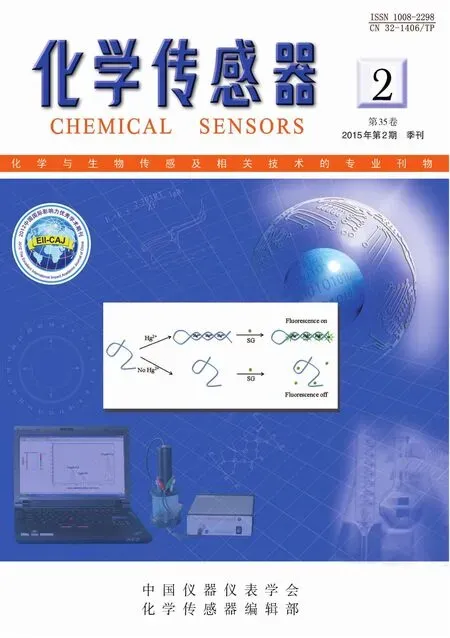以氧化还原探针为信号标签的多组分电化学传感器的研究进展
朱 强,唐荣霞,林 潇,田 雪
(重庆师范大学化学学院绿色合成与应用重点实验室,重庆400047)
0 引言
在临床分析中,同时测定一组肿瘤标志物对于癌症筛查和诊断具有重要的应用价值。在多分析物检测中,为了使每个生物标记物都能获得独立的响应信号,研究人员已经证实不同类型的材料可用作信号区分物质,包括纳米线[1-2],条形码[3-9],酶[10-12],量子点[13-15](QD),染料掺杂的纳米颗粒[16],金属离子[17]。近年来,以氧化还原探针为区分信号标签的策略令人关注,一些以氧化还原探针为标签的可同时检测多种分析物的电化学传感器已被提出。该文就对该类传感器的研究现状进行评述。按照传感器检测的界面数目可以被分为两类:多检测界面的阵列和单一检测界面的传感器。
1 多检测界面的阵列传感器
多检测界面主要是基于多通道分析,可以在一次分析中同时定量检测一组生物标志物,因此与传统的单组分免疫分析相比,它不仅具有更高的分析效率,而且可以大大提高临床诊断的特异性。此外,多通道分析还可以大大缩短分析时间,提高检测通量,减小样品用量和检测成本。因此,基于不同测量技术的各种多通道免疫分析方法近年来得到了快速发展[18]。主要以各种空间分隔的阵列或芯片为主[19-23]。Ávila等设计了一种一次性的免疫感器检测氨基末端B型利钠肽(NT-proBNP),如图1所示,抗原被共价固定到羧酸改性的活化磁珠(HOOC-MBS)上,在混合溶液含有不同浓度的抗原和HRP标记的检测抗体,样品中的目标NT-proBNP和固定在MB的抗原竞争HRP标记的第二抗体,再加入3,3,5,5-四甲基联苯胺 (TMB)为电子转移介体,检测线性范围0.12~42.9 ng/mL,检测限为 0.02 ng/mL[24]。

图1 磁力免疫传感器的间接竞争检测NT-proBNP的示意图和在金/SPE上TMB还原过氧化氢用的原理[24]Fig.1 Schematic display of the indirect competitive NT-proBNP magnetoimmunosensor developed and the enzyme and electrode reactions involved in the amperometric detection of the mediated reduction of H2O2with TMB at the Au/SPE
Silva等利用基于胺基功能化的碳纳米管的印刷电极无标记免疫传感器检测肌钙蛋白T(cardiactroponin T,一种急性心肌梗死的重要标记物),通过差分脉冲伏安法在铁氰化物存在的条件下检测(如图2所示),线性范围是0.0025~0.5 ng/mL,检测限为0.0035 ng/mL[25]。

图2 免疫传感器修饰(a)和检测的电化学原理(b)的示意图[25]Fig.2 Schematic representation of the(a)immunosensor fabrication and(b)electrochemical principle of detection
2 单一检测介面类型的多分析物传感器
阵列类型的传感器将不同的检测生物活性材料分别固载在不同的工作电极单元上,为了避免邻近的工作电极之间可能存在的互相干扰,各工作电极的检测需要在各自单独的反应池中分别进行,使得操作相对繁杂,批间差异较大;另外,检测用的芯片大多数都为一次性使用,成本较高,会带来一些环境污染和资源浪费方面的问题。由此一些研究者将注意力转向由单一介面进行多分析物检测的电化学传感器的研究中。
2.1 以量子点为信号识别标签的传感器
Wang等将不同的蛋白抗体采用不同的量子点ZnS,CdS,PbS和CuS分别进行标记,结合酸洗检测离子活度,构建的夹心型电化学免疫传感器成功实现了在同一敏感界面多组分的同时电化学检测,同时检测了微球蛋白、IgG、牛血清白蛋白和C-反应蛋白四种蛋白质[26]。 其原理如图3所示。
2.2 以金属磷酸盐为信号识别标签的传感器
Liu等以脱铁蛋白为模板,通过合成不同的金属磷酸盐纳米颗粒,用生物素对其进行功能化,含有不同金属元素的纳米颗粒分别标记到不同的抗体上,通过酸解作用释放出金属离子,用方波溶出伏安法测定出不同的金属离子的浓度,间接实现对抗原含量的检测,其结合方式及检测原理如图4所示[27]。

图3 根据不同的无机胶体纳米晶体作为示踪剂检测多种蛋白质的方法。(A)引入抗体修饰的磁珠;(B)磁性珠粒的抗体结合抗原;(C)捕获的纳米晶体标记的第二抗体;(D)剥离纳米晶体和电化学检测[26]Fig.3 Multiprotein electrical detection protocol based on different inorganic colloid nanocrystal tracers.(A)Introduction of antibody-modified magnetic beads;(B)binding of the antigens to the antibodies on the magnetic beads;(C)capture of the nanocrystal-labeled secondary antibodies;(D)dissolution of nanocrystals and electrochemical stripping detection

图4 制备金属磷酸盐纳米粒子的标签和电化学免疫检测的原理示意图[27]Fig.4 Schematic representation of the preparation of metal phosphate nanoparticle labels and principle of electrochemical immunoassay protocol
2.3 以氧化还原探针为信号识别标签的传感器
氧化还原探针为信号标签可避免量子点标记中复杂的合成过程和繁琐的酸洗过程,此方法使用不同的峰位置区分相应的检测物,以氧化还原探针的峰信号强度来指明分析物浓度,此方法简单快捷,具有较大的发展潜力。Song等以硫堇标记的抗AFP和二茂铁标记的抗CEA作为示踪剂,铂纳米粒子和辣根或氧化物酶(HRP)协同作用对过氧化氢还原效地放大的应答信号,免疫传 感器对 CEA 的线性范围为 0.3~45.0 ng/mL,斜率为 0.3106,检测下限为 0.05 ng/mL;对 AFP的线性范围为 0.5~50.0 ng/mL, 检测下限为 0.08 ng/mL[28]。如图5所示。

图5 免疫传感器的制备过程和抗体-抗原的相互作用示意图。Ab1和Ab2分别为代表一级抗体(捕获抗体)和示踪剂第二抗体(信号抗体)[28]Fig.5 Schematic illustration of the stepwise immunosensor fabrication process and interaction of antibody-antigen;Ab1 and Ab2 represent the primary antibody(capture antibody)and tracer secondary antibody(signal antibody),respectively
Bai等以石墨烯为载体分别标记不同的电活性物质硫堇和二茂铁,构建夹心型电化学适体传感器,实现了同一敏感界面对于血小板源性生长因子(PDGF)和凝血酶的同时检测。对前者的检测范围为0.01~35 nmol/L, 检测限为 8 pmol/L,后者检测范围为 0.02~45 nmol/L, 检测限为 11 pmol/L[29]。如图6所示。

图6 (A)双酶和适体II功能化的纳米铂-氧化还原探针-石墨烯纳米复合物的制备过程图。(B)适体传感器的构建过程示意图[29]Fig.6 (A)Preparation procedure of aptamers,GOD and HRP multi-labeled PtNPs-redox probes-rGS nanocomposites:(B)Schematic illustration of the stepwise aptasensor fabrication process
Xiang等采用目标物引发的适体释放和回填杂交得到带有氧化还原探针的单链DNA进行检测的方法,同时检测溶菌酶和腺苷。检测范围分别为 1~200 nmol/L 和 0.1~200 mmol/L[30]。 如图 7所示。

图7 基于适体,信号增强和多复合物回填方法同时检测溶菌酶和腺苷的示意图[30]Fig.7 Illustration of the aptamer-based,signal-on and multiplexed back-filling protocol for one-spot simultaneous electronic detection of lysozyme and adenosine
Li等利用三种探针硫堇(Thi)、羧基二茂铁(Fc-COOH)和联吡啶钴(Co(bpy)33+)分别标记三种抗体作为信号标签,以纳米金包覆碳纳米管作为载体,通过夹心免疫法进行测定,免疫传感器对 AFP 的线性范围为 0.025~5.0 ng/mL, 检测下限为 8.3 pg/mL; 对 AFP-L3的线性范围为0.014~2.7 ng/mL,检测下限为 4.7 pg/mL;对 APT的线性范围为 0.018~3.6 ng/mL, 检测下限为 6.0 pg/mL[31]。其检测原理如图8所示。
Zhu 等利用蒽醌-2-羧酸(Aq),硫堇(Thi),联吡啶钴(Co)羧基二茂铁(Fc),作为信号标签,同时检测四种生物标志物,CEA,CA125,CA19-9和CA242,其中CEA的线性范围 0.016~15 ng/mL;CA19-9 是 0.008~10 ng/mL;CA125 是0.012~12 ng/mL;CA242 是 0.010~10 ng/mL。 它们的检测限分别为 4.2,2.8,3.3 和 3.8 pg/mL[32]。 如图9所示。

图8 (A)纳米金/碳纳米管抗体@氧化还原探针生物共轭物的制备方法;(B)免疫传感器的制造过程[31]Fig.8 (A)The preparation procedure of the AuNPs/CNTs–antibody@redox probe bioconjugates.(B)The fabrication process of the immunosensor

图9 免疫传感器同时检测CEA,CA19-9,CA125和CA242的定量分析性能[32]Fig.9 Quantitative analysis performance of the immunosensor for simultaneous detection of CEA,CA19-9,CA125 and CA242
Yang等利用含有三个检测单元的免疫电极,以蒽醌-2-羧酸(Aq),硫堇(Thi)为信号探针,同时 检 测 6 种 生 物 标 志 物 ,AFP,AFP-L3,APT,AFU,DCP 和 c-GT, 检测范围 DCP 为 0.0320~3.20 AU/L,AFP-L3 为 0.0240~2.40 ng/mL,c-GT为 1.00~9.5 U/L,AFU 为 1.20~9.00 U/L,AFP 为0.0250~5.00 ng/mL,APT 为 0.0240~9.60 ng/mL,检测限分别为 0.010 AU/L,0.0080 ng/mL,0.33 U/L,0.40 U/L,0.0080 ng/mL,0.0082 ng/mL[33]。 如图 10所示。

图10 免疫传感器同时检测AFP,AFP-L3,APT,AFU,DCP和c-GT的定量分析性能[33]Fig.10 Quantitative analysis performance of the immunosensor for simultaneous detection of AFP,AFP-L3,APT,AFU,DCP and c-GT
3 结论
氧化还原探针标记多分析物技术输出效率高,方法简便,引起越来越多的关注。随着这个方法的发展,一些问题被提出来:一是认为由于同一电极界面存在多个生物反应,相比传统的单分析物检测,反应空间不足,可能导致较低的信号强度和检测限;二是如何避免几个反应相互干扰;三是较阵列传感器其优势何在;四是如何将这种技术应用于芯片或阵列中,在不增加检测单元或增加设备的情况下提高每个检测单元的检测效能。总的来说,氧化还原探针标记的多分析物研究目前较少,仍处于早期发展的阶段,有待进一步的完善和提高。
[1]Walton I D,Norton S M,Balasingham A,et al.Particles for multiplexed analysis in solution:detection and identification of striped metallic particles using optical microscopy[J].Anal.Chem.,2002,74(10):2240-2247.
[2]Tok J B,Chuang F Y,Kao M C,et al.Metallic striped nanowires as multiplexed immunoassay platforms for pathogen detection[J].Angew.Chem.Int.Ed.,2006,45(41):6900-6904.
[3]Nicewarner-Peña S R,Freeman R G,Reiss B D,et al.Submicrometer metallic barcodes[J].Science,2001,294(5540):137-141.
[4]Sha M,Walton I,Norton S,et al.Multiplexed SNP genotyping using nanobarcode particle technology[J].Anal.Bioanal.Chem.,2006,384(3):658-666.
[5]Stoeva S I,Lee J S,Smith J E,et al.Multiplexed detection of protein cancer markers with biobarcoded nanoparticle probes[J].J.Am.Chem.Soc.,2006,128(26):8378-8379.
[6]Pregibon D C,Toner M,Doyle P S.Multifunctional en-coded particles for high th-roughput biomolecule analysis[J].Science,2007,315(5817):1393-1396.
[7]Stoeva S I,Lee J S,Thaxton C S,et al.Multiplexed DNA detection with biobarcoded nanoparticle probes[J].Angew.Chem.Intern.Edit.,2006,45(20):3303-3306.
[8]Thaxton C S,Hill H D,Georganopoulou D G,et al.A Bio-barcode assay based upon dithiothreitol-induced oligonucleotide release[J].Anal.Chem.,2005,77:8174-8178.
[9]Taton T A,Mirkin C A,Letsinger R L.Scanometric DNA array detection with nanoparticle probes[J].Science,2000,289:1757-1760.
[10]Wilson M,Nie W.Electrochemical Multianalyte immunoassays using an array-based sensor[J].Anal.Chem.,2006,78(8):2507-2513.
[11]Wilson M,Nie W.Multiplex measurement of seven tumor markers using an electro-chemical protein chip[J].Anal.Chem.,2006,78(18):6476-6483.
[12]Fu Z F,Yang Z J,Tang J H,et al.Channel and substrate zone two-dimensional resolution for chemiluminescent multiplex immunoassay[J].Anal.Chem.,2007,79(19):7376-7382.
[13]Han M,Gao X,Su J Z,et al.Quantum-dot-tagged microbeads for multiplexed optical coding of biomolecules[J].Nat.Biotech.,2001,19(7):631-635.
[14]Allen C N,Lequeux N,Chassenieux C,et al.Optical analysis of beads encoded with quantum dotscoated with a cationic polymer[J].Adv.Mater.,2007,19(24):4420-4425.
[15]Liu J W,Lee J H,Lu Y.Quantum dot encoding of aptamer-linked nanostructures for one-pot simultaneous detection of multiple analytes[J].Anal.Chem.,2007,79(11):4120-4125.
[16]Yan J,Estévez M C,Smith J E,et al.Dye-doped nanoparticles for bioanalysis[J].Nano Today,2007,2(3):44-50.
[17]Hayes F J,Halsall H B,Heineman W R.Simultaneous immunoassay using electro-chemical detection of metal ion labels[J].Anal.Chem.,1994,66(11):1860-1865.
[18]Wu J,Fu Z F,Yan F,et al.Biomedical and clinical applications of immunoassays and immunosensors for tumor markers[J].TrAC,Trends Anal.Chem.,2007,26(7):679-688.
[19]Meyerhoff M E,Duan C M,Markus M.Novel nonseparation sandwich-type electro-chemical enzyme immunoassay system for detecting marker proteins in undiluted blood[J].Clin.Chem.,1995,41:1378-1384.
[20]Song S P,Li B,Hu J,et al.Simultaneous multianalysis for tumor markers by antibody fragments microarray system[J].Anal.Chim.Acta,2004,510:147-152.
[21]Petrou P S,Kakabakos S E,Christofidis I,et al.Multianalyte capillary immunosensor for the determination of hormones in human serum samples[J].Biosens.Bioelectron.,2002,17(4):261-268.
[22]Malhotra R,Patel V,Chikkaveeraiah B V,et al.Ultrasensitive detection of cancer biomarkers in the clinic by use of a nanostructured microfluidic array[J].Anal.Chem.,2012,84(14):6249-6255.
[23]Yurkovetsky Z R,Kirkwood J M,Edington H D,et al.Cancer therapy:Clinical multiplex analysis of serum cytokines in melanoma patients reated with interferon-A2b[J].Clin.Cancer Resea.,2007,13(10):2422-2428.
[24]Ávila B E,Escamilla-Gómez V,Campuzano S,et al.Disposable amperometric magnetoimmunosensor for the sensitive detection of the cardiac biomarker amino-terminal pro-B-type natriuretic peptide in human serum[J].Ana.Chim.Acta,2013,784:18-24.
[25]Silva B V,Cavalcanti I T,Silva M M,et al.A carbon nanotube screen-printed electrode for label-free detection of the human cardiac troponin T[J].Talanta,2013,117:431-437.
[26]Liu G D,Wang J,Kim J,et al.Electrochemical coding for multiplexed immunoassays of proteins[J].Anal.Chem.,2004,76(23):7126-7130.
[27]Liu G D,Wu H,Wang J,et al.Apoferritin templated synthesis of metal phosphate nanoparticle labels for electrochemical immunoassay[J].Small,2006,2(10):1139-1143.
[28]Song Z J,Yuan R,Chai Y Q,et al.Horseradish peroxidase-functionalized Pt hollow nanospheres and multiple redox probes as trace labels for a sensitive simultaneous multianalyte electrochemical immunoassay[J].Chem.Commun.,2010,46(36):6750-6752.
[29]Bai L J,Yuan R,Chai Y Q,et al.Simultaneous electro chemical detection of multiple analytes based on dual signal amplification of single-walled carbon nanotubes and multi-labeled graphene sheets[J].Biomaterials,2012,33(4):1090-1096.
[30]Xiang Y,Qian X Q,Jiang B Y,et al.An aptamer-based signal-on and multiplexed sensing platform for one-spot simultaneous electronic detection of proteins and small molecules[J].Chem.Commun.,2011,47(16):4733-4735.
[31]Li Y,Zhong Z Y,Chai Y Q,et al.Simultaneous electrochemical immunoassay of three liver cancer biomarkers using distinguishable redox probes as signal tags and gold nanoparticles coated carbon nanotubes as signal enhancers[J].Chem.Commun.,2012,48(4):537-539.
[32]Zhu Q,Chai,Y Q,Yuan R,et al.Simultaneous detection of four biomarkers with one sensing surface based on redox probe tagging strategy[J].Anal.Chim.Acta,2013,800:22-28.
[33]Yang Z H,Zhuo Y,Chai Y Q,et al.High throughput immunosenor based on multi-label strategy and a novel array electrode[J].Sci.Rep.,2014,4:4747-4753

